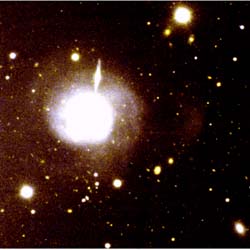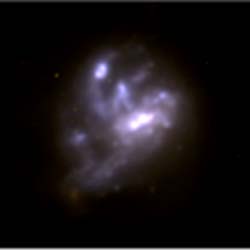New WIYN Telescope image dissects a starburst galaxy
 
|
In the galactic zoo, starburst galaxies are some of the more intriguing types of galaxies because of the furious pace at which they create new stars.
Nearby examples of luminous starbursts often have blue cores and peculiar diffuse outer structures. These may reveal the origins of starbursts – phases of hyperactive star formation — and shed light on the big picture of galactic evolution.
New images captured by the 3.5 meter WIYN Telescope on Kitt Peak, Ariz., depict the galaxy NGC 7673, including (top) its clumpy core, which contains massive clumps of young stars and more nebulous ripples in its outermost stellar disk. The bottom image shows a view of the same galaxy with the core stripped out to better depict the inner structure of NGC 7673. The galaxy is located in the constellation Pegasus and is some 150 million light years from Earth.
Astronomers do not know precisely what causes starburst galaxies or where the stars in the outer ripples come from, although both phenomena in collisions between galaxies. The stellar ripples may come from stars that have been bumped off course within NGC 7673 or, alternatively, they may come from beyond the galaxy — perhaps from a much smaller galaxy nearby — pulled in by the galaxy’s massive gravitational forces.
The image shows the galaxy long after any collision, and the galaxy will eventually settle down to a more mundane lifestyle with reduced star formation levels, and may one day even resemble a normal spiral galaxy like the Milky Way.
The WIYN Telescope was built and is operated by a consortium that includes the University of Wisconsin–Madison, Indiana University, Yale University and the National Optical Astronomical Observatories, an arm of the National Science Foundation.
The team of astronomers that made this observation of NGC 7673 includes UW–Madison graduate students Nicole Homeier and Chris J. Conselice, and UW–Madison astronomy Professor John S. Gallagher III.
Tags: research



